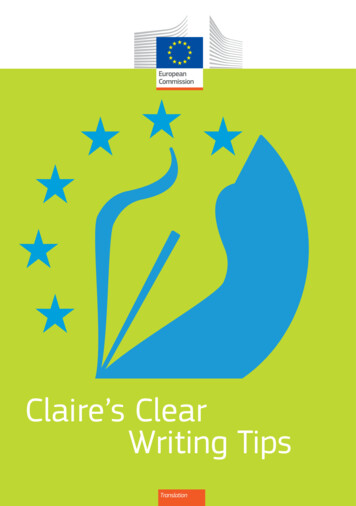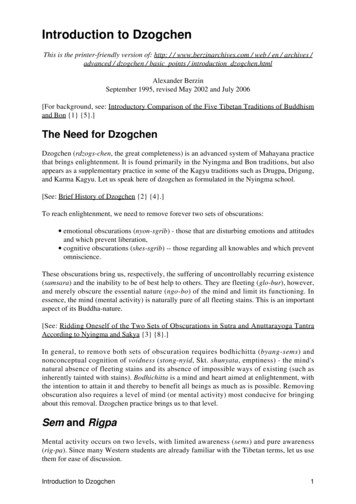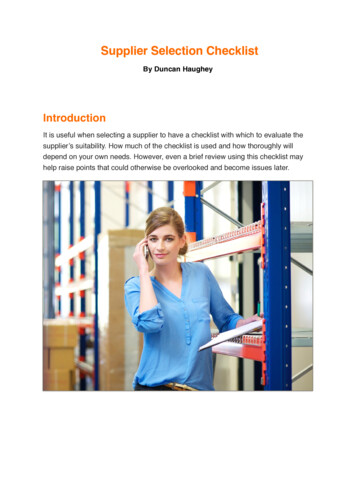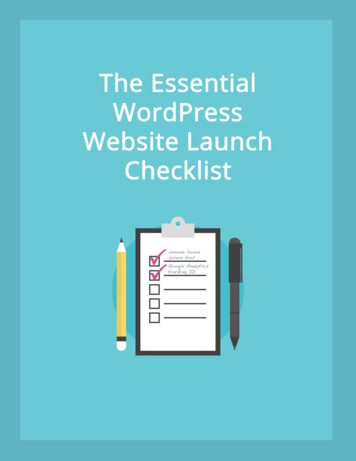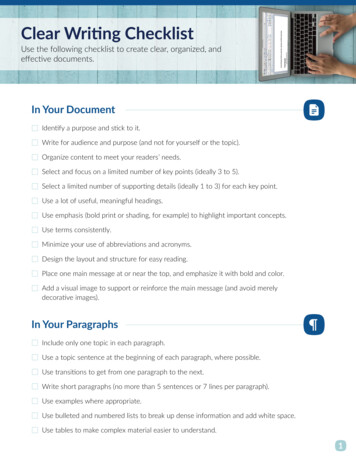
Transcription
Clear Writing ChecklistUse the following checklist to create clear, organized, andeffective documents.In Your DocumentIdentify a purpose and stick to it.Write for audience and purpose (and not for yourself or the topic).Organize content to meet your readers’ needs.Select and focus on a limited number of key points (ideally 3 to 5).Select a limited number of supporting details (ideally 1 to 3) for each key point.Use a lot of useful, meaningful headings.Use emphasis (bold print or shading, for example) to highlight important concepts.Use terms consistently.Minimize your use of abbreviations and acronyms.Design the layout and structure for easy reading.Place one main message at or near the top, and emphasize it with bold and color. dd a visual image to support or reinforce the main message (and avoid merelyAdecorative images).In Your ParagraphsInclude only one topic in each paragraph.Use a topic sentence at the beginning of each paragraph, where possible.Use transitions to get from one paragraph to the next.Write short paragraphs (no more than 5 sentences or 7 lines per paragraph).Use examples where appropriate.Use bulleted and numbered lists to break up dense information and add white space.Use tables to make complex material easier to understand.1
In Your SentencesMake each sentence about one thing or serve one purpose.Use pronouns like “you” and “we” where appropriate to speak directly to readers.Use active voice (not passive voice).Make the action of each sentence clear through use of a clear, strong verb.Use the simplest form of verbs (e.g., “use” not “utilize”).Avoid using hidden verbs (e.g., “analyze” not “conduct an analysis”).Use “must” to indicate requirements (not “shall”).Use contractions when appropriate.Don’t use jargon or unnecessary technical terms.Use short, simple words.Don’t cluster a bunch of nouns together.Omit unnecessary words.Don’t use slashes.Write short sentences (no more than 20 words per sentence).Keep the subject and verb close together.Place the main idea before exceptions and conditions.Place modifiers next to the words they modify.Pay attention to what you placed at the end of each sentence (because readers tend toremember that).2
Supporting Information for ChecklistIn Your DocumentIdentify a purposeA clearly stated purpose helps create a focused document; all the separate pieces (pages,paragraphs, sections, images, etc.) can work together to achieve your specific goal.Write for your audienceUse language your audience knows and feels comfortable with. Take your audience’scurrent level of knowledge into account. Address separate audiences separately.Remember to write for audience and purpose and not for topic and author (yourself).In other words, what does your audience need to know, not what do you want to say.Organize to meet your readers’ needsStart by stating the document’s purpose and its bottom line. Put the most importantinformation at the beginning and include background information (when necessary)toward the end. Eliminate filler and unnecessary content.Select key points and detailsShort-term memory research demonstrates that, generally, people can process limitedbits of information at a time. Mapping methods—such as “Message Mapping”—suggestselecting 1 to 3 main messages and including 1 to 3 supporting details for each of themain messages or key points. This helps ensure that your reader will easily process,understand, and remember your message.Use lots of useful headingsThe best-organized document will still be difficult for users to follow if they can’t see howit’s organized. An effective way to reveal your document’s organization is to use lots ofuseful headings. A document with lots of informative headings is easy to follow becausethe headings break up the material into logical, understandable pieces. Like Goldilocks’sporridge, headings should be not too long, not too short, but just right (i.e., informativeand meaningful).Use emphasis to highlight important conceptsUse bold or italics to make important concepts stand out. PUTTING EVERYTHING INCAPITAL LETTERS IS NOT A GOOD EMPHASIS TECHNIQUE; IT MAKES IT HARDER TOREAD. AND IN ELECTRONIC COMMUNICATION, IT’S CONSIDERED SHOUTING.3
Similarly, underlining will draw the user’s attention to the section, but it makes it hard toread. Besides, in electronic communication, people expect underlined text to be a link. It’sbetter to use bold or italics for important issues.Use the same term consistentlyYou will confuse your audience if you use different terms for the same concept. For example,if you use the term “senior citizens” to refer to a group, continue to use this term throughoutyour document. Don’t substitute another term, such as “the elderly” or “the aged.”Minimize abbreviations and acronymsLimit the number of abbreviations and acronyms you use in one document to no more thanthree. The following tips can help reduce acronyms and abbreviations: Use names such as “the committee” or “the report” in place of acronyms. I f you use the abbreviation or acronym only a couple of times in a document, spell itout instead.Design your document for easy readingHere are a couple of brief guidelines for good document design: Use lists and tables often but don’t overuse them. Don’t have lists within lists. Lists should have no more than about 7 items. Rather than fully justifying your text, use ragged right margins.Place a main message at the topWhat is the one thing you want your reader to remember? This is your main message andshould be placed at or near the top of your document. Emphasize it by bolding it andmaking the font larger. Maybe even put it in a shaded text box.Add a visual image to support the main messageDon’t use images just to decorate your document. Carefully choose meaningful images thatsupport or illustrate the main message or key points. And never use an image that showsbehavior you want your reader to avoid or change. For example, if you want your reader tostay away from contaminated water, don’t choose an image that shows kids playing nearwater (even if the water in the image looks clean).4
In Your ParagraphsInclude only one topic in each paragraphYour readers will understand more readily the point you want to make if you confine eachparagraph to only one topic.Include a topic sentence in each paragraphIf you tell your readers what they’re going to read about, they’re less likely to have to readyour paragraph again. Headings help, but they’re not enough. Establish a context for youraudience before you provide them with the details. We often write the way we think—westate our premises first and then our conclusions. It may be the natural way to develop ourthoughts, but in so doing we wind up with the topic sentence at the end of the paragraph.Move that topic sentence to the beginning of the paragraph. Let readers know whereyou’re going. Don’t make readers hold a lot of information in their heads before they getto your point.Use transitions to get from one paragraph to the nextThink of your readers as all driving cars. They need signs and directions to help them getwhere you want them to go. Make sure they get those directions by linking paragraphstogether through transition words and sentences. Transitions needn’t be long and tedious.A transition can be as short as starting a succeeding paragraph with “but” or “still.”Write short paragraphs and vary your sentence lengthLong, wall-of-words paragraphs discourage your audience from even trying to understandyour material. Short paragraphs are easier to read and understand. Writing expertsrecommend paragraphs of no more than 150 words or 5 sentences. Vary the lengths ofyour paragraphs to make them more interesting.Use examplesExamples help you clarify complex concepts. In spoken English, when you ask forclarification of something, people often respond by giving you an example. Good examplescan substitute for long explanations. The more complex the concept you are writing about,the more you should consider using an example. And it’s okay to say, “For example, ”.Use listsLists highlight a series of requirements or other information in a visually clear way. Usevertical lists to help your user focus on important material. Vertical lists: Highlight levels of importance Help the user understand the order in which things happen5
Make it easy for the user to identify all necessary steps in a process Add blank space for easy reading Are an ideal way to present items, conditions, and exceptionsYour lists will be easier to read if you always use a lead-in sentence to explain your lists.Indent your lead-in sentence from the left margin and use left alignment only (never centerjustification). Keep lists short (no more than 7 bullets).Use tables to make complex material easier to understandTables help your audience see relationships that are often times hidden in dense text.Think about using a standard table or an “if-then” table.In Your SentencesFocus on one thing or purposeMake sure that your sentence is about one thing. If you overload a sentence with morethan one purpose, you are interfering with your readers’ comprehension, and you areasking them to interpret which is the more important message or purpose. They may focuson something different than what you wanted to emphasize.Address one person, not a groupYour document may affect a thousand people, but you are speaking to the one person whois reading it.Use active voiceActive voice is clear, concise, and direct. Passive voice can be wordy and awkward; it canalso disguise who does what. Use active voice unless you have a specific reason you wantto use passive (e.g., you don’t know who the actor was or you want to emphasize theaction or object).Make the action clearSometimes when a reader can’t decipher a sentence, it’s because the action is unclear.What’s happening or supposed to happen in the sentence? Make that clear through use ofa strong, clear verb.6
Use the simplest form of a verbThe simplest and strongest form of a verb is present tense. Using the present tense makesyour document more direct and forceful. Also, don’t use a more complicated version of theverb. For example, say “use” instead of “utilize.”Avoid hidden verbsA hidden verb is a verb converted into a noun. It often needs an extra verb to makesense. Instead of “Please make an application for a personal loan,” write “Please apply for apersonal loan.” Hidden verbs come in two forms. Some have endings such as -ment, -tion,-sion, and -ance or link with verbs such as achieve, effect, give, have, make, reach, andtake. Often, you will find a hidden verb between the words “the” and “of.”Use “must” to indicate requirementsThe word “must” is the clearest way to convey to your audience that they have to dosomething. “Shall” is one of those officious and obsolete words that has encumbered legal,bureaucratic-like writing for many years. “Shall” is also obsolete. When was the last timeyou heard it used in everyday speech?Use contractions when appropriateContractions help make your writing less stuffy and more natural. Contractions alsomake your writing more accessible to the user. Research shows that contractionsenhance readability; after all, people use contractions when they talk. So it’s okay to usecontractions, don’t you think?Don’t cluster nounsTechnical writing uses too many noun strings—groups of nouns “sandwiched” together.Readability suffers when three or more words that are ordinarily separate nouns followin succession. Technically, clustering nouns turns all but the last noun into adjectives.However, many users will think they’ve found the noun when they’re still readingadjectives, and will become confused. Eliminate descriptive words that aren’t essential. Or,use prepositions and articles to clarify the relationships among the words.Use pronouns to speak directly to readersPronouns help the audience picture themselves in the text and relate better to yourdocuments. Using “you” pulls users into your document and makes it relevant to them.Using “we” to refer to your agency makes your agency more approachable. It also makesyour sentences shorter and your document easier to read.7
Don’t use jargonBe concise—leave out unnecessary words. Don’t use jargon or technical terms wheneveryday words have the same meaning. Use words and terms consistently throughoutyour document.Use short, simple wordsVocabulary choice is an important part of communicating clearly. Be expressive, butremember that most federal writing has no place for literary flair. It’s not going to besomeone’s fireside reading. In making your word choices, pick the familiar or frequentlyused word over the unusual or obscure. As George Orwell said, “Never use a long wordwhere a short one will do.”Omit unnecessary wordsDon’t confuse your readers with long, complex sentences containing multiple phrases andclauses. One place to start working on this problem in your own writing is to watch outfor “of,” “to,” “on,” and other prepositions. You can also omit redundant words and avoiddoublets and triplets (i.e., when authors repeat the same concept by using different wordsthat say the same thing—such as “knowledge and information”). In other words, if it’spossible to cut a word out, always cut it out.Don’t use slashesApart from fractions, the slash has almost no good uses. “And/or” is a classic example.In most cases, writers mean either “or” or “and.” But they don’t want to take the timeto decide which they mean, so they push the job off on the audience. That makes theirwriting ambiguous. As an author, you should decide what you mean. In the few cases—andthere do seem to be very few—where you truly mean both, write out “either X, or Y, orboth.” Often when writers use slashes, a hyphen is more appropriate to join equal or liketerms, as in “faculty-student ratio.”Write short sentencesExpress only one idea in each sentence. Long, complicated sentences often mean that youaren’t sure about what you want to say. No sentence should exceed 25 words. Shortersentences are also better for conveying complex information; they break the informationup into smaller, easier-to-process units. Sentences loaded with dependent clauses andexceptions confuse the audience by losing the main point in a forest of words. Resist thetemptation to put everything in one sentence; break up your idea into its parts, and makeeach one the subject of its own sentence. Vary your sentence length to make your textmore interesting to the reader. That’s what Hemingway did—no reason why you can’tdo the same.8
Keep subject, verb, and object close togetherThe natural word order of an English sentence is subject-verb-object. This is how you firstlearned to write sentences, and it’s still the best way. When you put modifiers, phrases,or clauses between two or all three of these essential parts, you make it harder for yourreaders to understand you.Place the main idea before exceptions and conditionsWhen you start a sentence with an introductory phrase or clause beginning with “except,”you almost certainly force the reader to re-read your sentence. You are stating anexception to a rule before you have stated the underlying rule. The audience must absorbthe exception, then the rule, and then usually has to go back to grasp the relationshipbetween the two. Material is much easier to follow if you start with the main idea and thencover exceptions and conditions.Place words carefullySloppy word placement can cause ambiguity. To reduce ambiguity, put conditionals suchas “only” or “always” and other modifiers next to the words they modify. Write “youare required to provide only the following,” not “you are only required to provide thefollowing.”Pay attention to what comes lastSome researchers have found that readers tend to remember or give emphasis to whatcomes at the end of a sentence (see Gopen reference below). Pay attention to what youplace at the end of sentence. Is that what you want readers to remember as they move tonext sentence?ReferencesThe NCEH/ATSDR Office of Communication, Writer-Editor Services, developed thischecklist and supporting materials using the following sources: Federal Plain Language Guidelines (available at www.plainlanguage.gov) M essage Mapping, Vincent T. Covello, PhD (available at formation/resources/Covello message mapping.pdf) T he Science of Scientific Writing, George Gopen and Judith Swan (available at e-science-of-scientific-writing/1)9
Clear Writing Checklist Use the following checklist to create clear, organized, and . effective documents. In Your Document. Identify a purpose and stick to it. Write for audience and purpose (and not for yourself or the topic). Organize content to meet your readers’ needs. Select and



